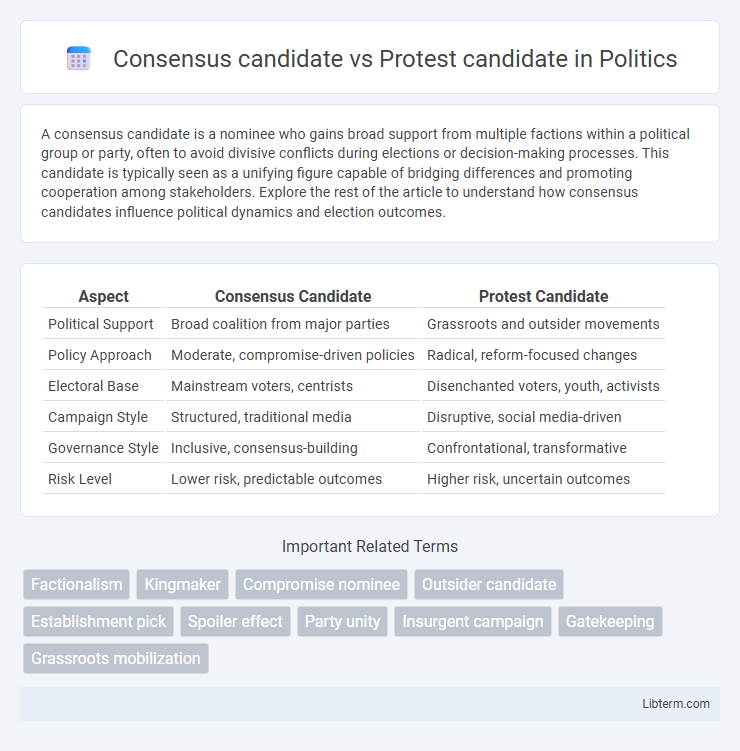A consensus candidate is a nominee who gains broad support from multiple factions within a political group or party, often to avoid divisive conflicts during elections or decision-making processes. This candidate is typically seen as a unifying figure capable of bridging differences and promoting cooperation among stakeholders. Explore the rest of the article to understand how consensus candidates influence political dynamics and election outcomes.
Table of Comparison
| Aspect | Consensus Candidate | Protest Candidate |
|---|---|---|
| Political Support | Broad coalition from major parties | Grassroots and outsider movements |
| Policy Approach | Moderate, compromise-driven policies | Radical, reform-focused changes |
| Electoral Base | Mainstream voters, centrists | Disenchanted voters, youth, activists |
| Campaign Style | Structured, traditional media | Disruptive, social media-driven |
| Governance Style | Inclusive, consensus-building | Confrontational, transformative |
| Risk Level | Lower risk, predictable outcomes | Higher risk, uncertain outcomes |
Understanding Consensus Candidates
Consensus candidates emerge from broad agreement among diverse groups, reflecting a unified support base that prioritizes shared values and goals over individual agendas. These candidates typically gain legitimacy through inclusive dialogue and compromise, resulting in stronger acceptance across political or organizational spectrums. Understanding consensus candidates involves recognizing their role in fostering stability and cooperation by bridging divides and addressing common interests effectively.
Defining Protest Candidates
Protest candidates are political figures who emerge primarily to challenge the prevailing establishment or mainstream consensus, often mobilizing discontent from marginalized or dissatisfied voter groups. Unlike consensus candidates who typically represent broad agreement within their parties and appeal to moderate electorates, protest candidates emphasize radical change, anti-establishment rhetoric, and unconventional platforms. Their campaigns focus on highlighting systemic failures and advocating for policies that disrupt the status quo, attracting voters seeking significant political and social reform.
Historical Examples of Consensus and Protest Candidates
Historical examples of consensus candidates include Dwight D. Eisenhower, who garnered broad bipartisan support during the 1952 U.S. presidential election due to his military leadership and moderate policies. In contrast, protest candidates like George Wallace in 1968 rose by capitalizing on voter dissatisfaction and challenging the political establishment. These distinctions highlight how consensus candidates often unify mainstream voters, while protest candidates mobilize disenfranchised or discontented segments of the electorate.
Key Differences in Political Strategy
Consensus candidates prioritize broad appeal by seeking support across multiple factions and focusing on unifying policies that resonate with diverse voter bases. Protest candidates emphasize mobilizing discontent and rallying voters dissatisfied with the status quo, often promoting radical or reformist agendas to challenge established power structures. The strategic choice between these approaches influences campaign messaging, coalition-building efforts, and voter targeting tactics.
Voter Appeal: Unity vs Disruption
Consensus candidates attract voter appeal through a platform of unity, emphasizing collaboration and common ground to bridge divides within the electorate. Protest candidates gain support by challenging the status quo and voicing dissatisfaction, resonating with voters seeking disruption and significant change. This dynamic highlights the contrast between stability-driven votes versus those motivated by a desire for transformative action.
Media Representation and Public Perception
Consensus candidates often receive positive media representation, highlighting their ability to unite diverse groups and foster stability, which strengthens public perception of them as reliable and moderate leaders. Protest candidates, by contrast, are frequently portrayed as polarizing figures challenging the status quo, attracting media attention through controversy and appealing to disenfranchised voters seeking radical change. This differential media framing directly influences public perception by either legitimizing consensus candidates as viable administrators or mobilizing support for protest candidates as agents of disruption.
Impact on Party Cohesion
Consensus candidates enhance party cohesion by bridging diverse factions and fostering unity through broad acceptance and collaborative decision-making. Protest candidates often challenge established norms and party leadership, which can deepen internal divisions and create factionalism within the party. The presence of a consensus candidate typically stabilizes party dynamics, while a protest candidate may energize some members but risks undermining collective solidarity.
Election Outcomes: Successes and Failures
Consensus candidates often achieve higher election success rates due to broader appeal across diverse voter groups, minimizing polarization and fragmentation within the electorate. Protest candidates typically gain traction by mobilizing discontented or marginalized voters but frequently face challenges translating grassroots energy into widespread electoral victories. Election outcomes demonstrate that consensus candidates tend to secure stable governance, while protest candidates risk electoral failure or limited influence despite strong initial momentum.
Implications for Democratic Processes
Consensus candidates foster political stability by promoting broad agreement across diverse groups, enhancing electoral legitimacy and reducing polarization. Protest candidates often challenge established norms and highlight systemic grievances, potentially increasing voter turnout but also risking political fragmentation and heightened tensions. The dynamic between consensus and protest candidates shapes democratic processes by influencing legitimacy, voter engagement, and the balance between stability and reform.
Future Trends in Candidate Selection
Future trends in candidate selection indicate a shift towards consensus candidates who can unite diverse voter bases and present pragmatic solutions, enhancing political stability. Protest candidates often gain traction during periods of widespread dissatisfaction but may struggle to sustain long-term influence as governance demands compromise and collaboration. Data from recent elections reveal increasing voter preference for candidates emphasizing inclusive policies over polarizing rhetoric, signaling a growing favorability toward consensus-driven leadership.
Consensus candidate Infographic

 libterm.com
libterm.com